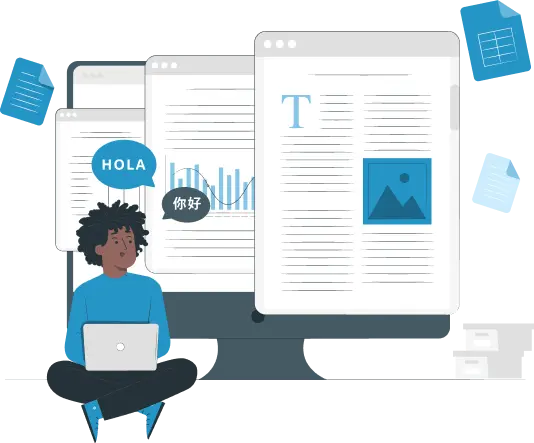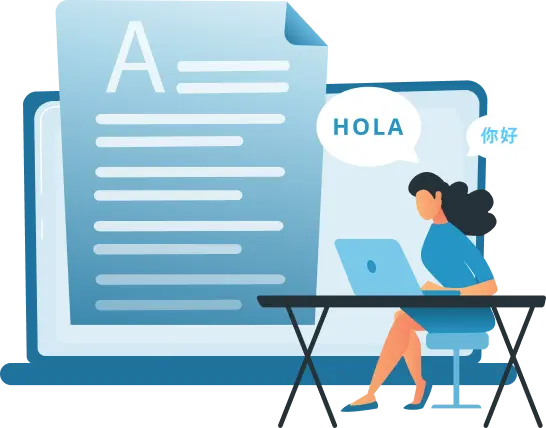
Local, Impactful Document Translation Services
The growing globalization trend highlights the significance of having your documents available in multiple languages. This encourages you to hire the best document translation services for optimal results. And CCJK is no doubt your leading choice with a track record of over 20 years that speaks for itself. We make document translation into any of the world’s languages easy and quick by assigning your project to top-rated and highly qualified native professionals. Our translators work by paying special attention to the natural flow and consistency, thus producing local translations that read well and resonate.
We Translate All Document Types
Whether it’s a single-page letter or a lengthy white paper, our best online document translation services will help you manage all kinds of documents.
- E-books
- Certificates
- Whitepapers
- Contracts
- Brochures
- Marketing Plans
- Business Policies
- User Guides
- Academic Documents

Formats we support
We’re a leading desktop publishing company that can work with all types of documents using a wide range of desktop publishing tools, such as:
Industry-Specific Document Translation Services
We’re leaders in professional document translation services. Our experts can craft localized versions of your all-important documents no matter what industry or sector you operate in.

Technical Document Translations

Aviation Document Translations

Medical Document Translations

Government Document Translations

Manufacturing Document Translations

Telecom Document Translations
Technical Document Translations
Consistent quality is what encourages every company towards our technical document translations. We achieve this by assigning you a relevant expert who knows your specialty area and is capable of handling all the complex terms accurately and efficiently. Work with us today, and we will provide you with certified document translation services for engineering, legal, software, and financial documents, among many others.
Aviation Document Translations
We offer official document translation services for the aviation and aerospace industry. Our aviation document translations are available for all areas of this industry, such as civil aviation, defense and military aviation, strategic aviation, and more. Aviation clients who regularly seek our translation services for documents are airlines, airline parts manufacturers, aircraft manufacturers, and private air charters, among others.
Medical Document Translations
Quality translation is a basic need of every industry, but this becomes much more relevant and important in the medical field. Since a medical document includes sensitive information, any error or mistranslation can be fatal. Therefore, our document translation agency matches you with linguists who have years of experience in the medical industry. Leveraging their industry-specific expertise, they deliver accurate results in everything they translate from patient consent forms to medical journals.
Government Document Translations
We’re your preferred document translation services agency. Our state-of-the-art government document translations are available for all local, state, federal, and national government documents. Our native linguists are experts in translating government publications, policies, the text of laws, pamphlets, testimonies, contracts, etc. in any format you send to us. We work around the clock and can help you overcome language barriers whenever you need us on your side.
Manufacturing Document Translations
We offer document language translation services specifically for the manufacturing sector. Our team of translators has subject matter expertise in various manufacturing fields, from electronics to automotive and home appliances. Just let us know which manufacturing document you need language translation for. Be it some SOPs, technical manuals, raw material specifications, or intellectual property ownership, we’ve got you covered for both official and personal document translation services.
Telecom Document Translations
CCJK is a leading document translation company that provides keenly adapted, appropriately formatted, and error-free telecommunication document translations that encompass the complete essence of the source documents. Want to supercharge your global expansion and growth opportunities? Our services allow you to get your user guides, installation manuals, press releases, and marketing materials translated into the local languages and dialects of your target audience.
Ready to compete on a global level?
How We Translate Your Documents
Preparation and Planning
In this phase, we work with you to create a detailed translation plan. This includes things like identifying your target audience, creating a workflow, setting up turnaround time, and forming a team.
1
Project Execution
Our native experts start adapting textual components of your documents. At the end of this phase, we compile a fully localized version of your document as per your instructions.
2
Post-translation Testing
In the last step, we perform the linguistic and cultural testing of the whole document. If there’s any issue, we will apply appropriate edits and then send you the completed project.




